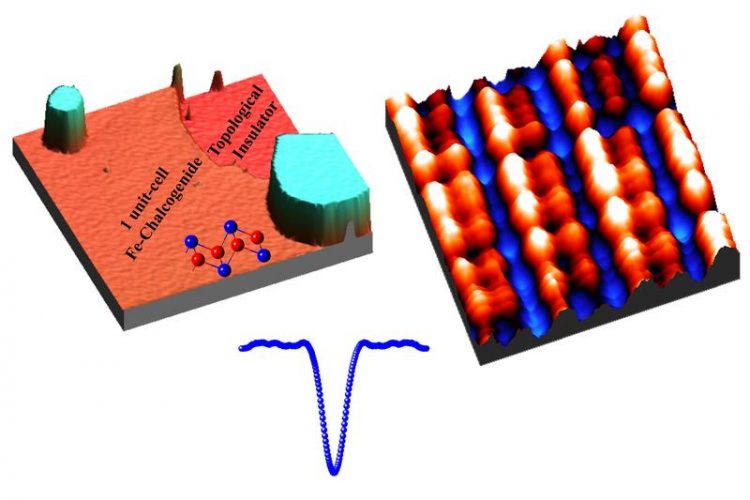Interfacial Superconductivity: Magnetic and superconducting order revealed simultaneously

(left) Scanning tunneling microscopy (STM) image (perspective view) of a heterostructure interface consisting of two non-superconducting materials, namely a topological insulator as substrate and an ultrathin film of iron-telluride grown on top. The unit-cell high layer of FeTe exhibits simultaneously bi-collinear antiferromagnetic order as revealed by spin-resolved STM (right) and superconducting properties at the same location as measured by the spectroscopic STM mode (bottom). Image source: S. Manna and R. Wiesendanger, University of Hamburg, Germany
While superconductivity and magnetism are generally believed to be mutually exclusive, surprisingly, in this new material, superconducting correlations spatially coexist with antiferromagnetism.
Most remarkably, the team headed by Professor Roland Wiesendanger was able to observe this coexistence for the first time on the atomic scale using spin-resolved scanning tunneling microscopy and spectroscopy.
These exciting results, reported in today’s issue of Nature Communications, challenge the understanding of the nature of electronic Cooper-pairing in iron based superconductors, which is the class of superconducting materials most heavily studied in recent years.
The discovery of high-temperature superconductivity in iron based compounds initiated numerous studies on the relationship between magnetic and superconducting order by various experimental and theoretical methods. Moreover, the unusual enhancement of the superconducting transition temperature by interface effects, as reported a few years ago for the case of ultrathin FeSe films grown on SrTiO₃ substrates, created additional excitement in the scientific community. Interestingly, in contrast to FeSe, the related compound FeTe does not exhibit a superconducting phase, but shows antiferromagnetic ordering up to a critical temperature of about 70 K.
Therefore, it is even more remarkable that ultrathin FeTe films grown on non-superconducting Bi₂Te₃ substrates show clear signs of superconductivity. The coupling of a superconductor to a topological insulator such as Bi₂Te₃, as realized in the experiments by the Hamburg group, is not only interesting from a fundamental research point of view:
It has been theoretically predicted that such hybrids can host Majorana Fermions in the center of superconducting vortex cores formed upon the application of an external magnetic field. Majorana Fermions are currently widely explored in different research disciplines as a new platform for fault-tolerant quantum computation. The fascinating results obtained for FeTe/Bi₂Te₃ heterostructures can therefore be regarded as an important step towards the experimental realization of such dreams.
Original publication:
Interfacial superconductivity in a bi-collinear anti-ferromagnetically ordered FeTe monolayer on a topological insulator,
S. Manna, A. Kamlapure, L. Cornils, T. Hänke, E. M. J. Hedegaard, M. Bremholm, B. B. Iversen, Ph. Hofmann, J. Wiebe, and R. Wiesendanger,
Nature Communications, online publication: 17.01.2017,
DOI: 10.1038/NCOMMS14074.
Further related work in the recent literature:
Reorientation of the diagonal double-stripe spin structure at Fe1+yTe bulk and thin film surfaces,
T. Hänke, U. R. Singh, L. Cornils, S. Manna, A. Kamlapure, M. Bremholm, E. M. J. Hedegaard, B. B. Iversen, Ph. Hofmann, J. Hu, Z. Mao, J. Wiebe, and R. Wiesendanger,
Nature Communications 8, 13939 (2017), online publication from 06.01.2017.
Primary research funding:
We are particularly grateful for research funding by the European Research Council in the framework of the ERC Advanced Grant ASTONISH.
Additional information:
Prof. Dr. Roland Wiesendanger
University of Hamburg
Jungiusstr. 9A/11A
D-20355 Hamburg
Germany
E-Mail: wiesendanger@physnet.uni-hamburg.de
Phone.: +49- 40 – 4 28 38 – 52 44
Media Contact
All latest news from the category: Materials Sciences
Materials management deals with the research, development, manufacturing and processing of raw and industrial materials. Key aspects here are biological and medical issues, which play an increasingly important role in this field.
innovations-report offers in-depth articles related to the development and application of materials and the structure and properties of new materials.
Newest articles

Recovering phosphorus from sewage sludge ash
Chemical and heat treatment of sewage sludge can recover phosphorus in a process that could help address the problem of diminishing supplies of phosphorus ores. Valuable supplies of phosphorus could…

Efficient, sustainable and cost-effective hybrid energy storage system for modern power grids
EU project HyFlow: Over three years of research, the consortium of the EU project HyFlow has successfully developed a highly efficient, sustainable, and cost-effective hybrid energy storage system (HESS) that…

After 25 years, researchers uncover genetic cause of rare neurological disease
Some families call it a trial of faith. Others just call it a curse. The progressive neurological disease known as spinocerebellar ataxia 4 (SCA4) is a rare condition, but its…





















